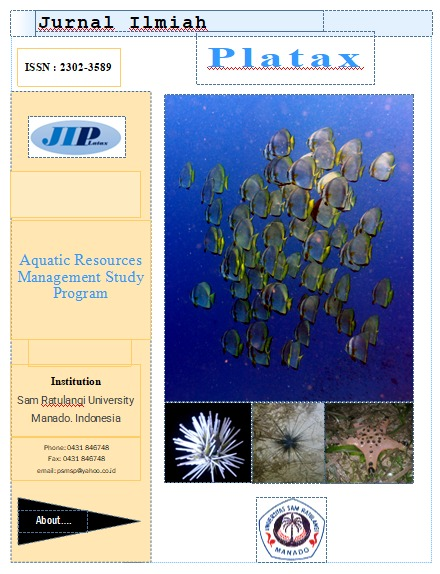Identification Of The Condition Of The Ship Wreck As A Diving Tourism Object In The Waters Of "Tawara" Bunaken National Park, North Sulawesi Province
DOI:
https://doi.org/10.35800/jip.v11i2.52089Keywords:
Tourism, Ship, Shipwreck, Bunaken, CoralAbstract
The coral reef ecosystem is a place to live, a place to breed, and even a place to find food for various kinds of marine biota, this is what makes this ecosystem a beautiful attraction as a tourist destination. In general, the waters of Bunaken Island, which are included in the Bunaken National Park Area, are one of the world's tourist destinations, which present coral reefs as a charm that can be enjoyed for their beauty and high level of biota diversity. The objectives of this research are: To identify the condition of existing shipwrecks; Identify corals attached to shipwrecks; and analyze the Suitability of diving tourism. The coral type Pocillopora verrucosa was found with a total of 45 colonies with an average growth of 7 cm, Ascidian Polycarpa Aurata the number of colonies found was 18 with an average growth of 3, Ascidian Didemnum mole the highest number of colonies found was 97 colonies with an average growth of 2 cm, while Cyphastrea microphthalmia number of colonies was 8 and the average growth was 3 cm. Analysis of tourism suitability for this location for diving tourism with an IKW value of 2.25, which based on the score means it is in the "suitable" category.
Keywords: Tourism, Ship, Shipwreck, Bunaken, Coral
Abstrak
Ekosistem terumbu karang sebagai tempat hidup, tempat berkembang biak, bahkan tempat mencari makan berbagai macam biota laut, hal inilah yang menjadikan ekosistem ini memiliki daya tarik yang indah untuk dijadikan destinasi wisata. Secara umum perairan Pulau Bunaken yang masuk dalam Kawasan Taman Nasional Bunaken, adalah salah Destinasi wisata Dunia, yang menghadirkan Terumbu karang sebagai pesona yang dinikmati keindahannya dan tingkat keanekaragaman biota yang tinggi. Adupun tujuan dari penelitian ini yaitu : Mengidentifikasi kondisi kapal karam yang ada; Mengidentifikasi karang yang menempel pada kapal karam; Menganalisis Kesesuaian wisata selam. Ditemukan karang berjenis Pocillopora verrucosa dengan jumlah koloni 45 dengan pertumbuhan rata-rata 7 cm, Ascidian Polycarpa Aurata jumlah koloni yang ditemukan 18 pertumbuhan rata-rata 3, Ascidian Didemnum mole jumlah koloni yang terbanyak ditemukan 97 koloni dengan pertumbuhan rata-rata 2 cm, sedangkan Cyphastrea microphthalma jumlah koloni 8 dan pertumbuhan rata-rata 3 cm. Ananlisis kesesuaian wisata untuk lokasi tersebut untuk wisata selam dengan nilai IKW, 2,25 yang berdasarkan skor artinya dalam kategori “sesuai”.
Kata Kunci : Wisata, Kapal, Karam, Bunaken, Karang
References
Arrigoniet, 2017 dalam “Inventarisasi Ragam Karang di Pantai Bandengan, Kabupten Jepara, Jawa Tengah” Lilla P Faizsyahrani, Ade R Pertiwi, Windi P Firdhiana3, Septiana N Kholifah. Vol. 1 No. 1 (2022): SNSE VIII, 26-34 Universitas PGRI Semarang, 27 Agustus 2022ISSN: 2964-1411
Belec Antoine (2009), Lien sur cette fiche ascidie tache d'encre - Polycarpa aurata. http://souslesmers.free.fr/f.php?e=1276
El-Kady, Marwa. 2017. “Potentials of Underwater Cultural Heritage in Tourism from the Perspective of Tour Guiding in Alexandria, Egypt.” Tourism Research Institute, Journal of Tourism Research 17 (1): 222–37.
Gunn dan Turgut (2002), Tourism planning: basics, concepts, cases: 4th Edition, London Hukom, F. D., 1998. Ekostruktur dan Organisasi Spasial-Temporal Ikan Karang di Perairan Teluk Ambon. Tesis S-2 Program Pasca Sarjana IPB, Bogor.
Indroyono. 2000. Peranan Panitia Nasional Pengangkatan dan Pemanfaatan Benda Berharga Asal Muatan Tenggelam in Diskusi Harta Karun Bawah Air Tantangan Bagi Arkeologi, Jakarta 4 Juli 2000.
Jhon E. Randall. Gerald R. Allen. Roger C. Steene (1990) FISHSES of the GREAT BARRIER REEF and CORAL SEA
Mehta, A. 1999. Buku Panduan Lapangan Taman Nasional Bunaken (Bunaken National Park History Book). Supported by USAID melalui Program NRM/EPIQ. 271 halaman
Nontji, A. 1993. Laut Nusantara. Penerbit Djambatan. Jakarta.
Nybakken J. 1988. Biologi Laut; Suatu Pendekatan Ekologis. Penerbit Gramedia-Jakarta. 459 halaman
Peta Kota Manado di disadur dalam https:// petatematikindo.wordpress.com /2015/02/26/ administrasi-kota-manado
Santhanam, R., & S. Ramesh. 2019. Biology and Ecology of Pharmaceutical Marine Tunicates. CRC Press.
Sadarun. 1999. Transplantasi Karang Batu Di Kepulauan Seribu, Teluk Jakarta. Tesis. Fakultas Perikanan dan Ilmu Kelautan. Institut Pertanian Bogor. 67p.
Soto D, Stephane De Palmas,Ming Jay Ho,Vianney Denis (2018). Spatial variation in the morphological traits of Pocillopora verrucosa along a depth gradient in Taiwan. Published: https://doi.org/10.1371/journal.pone.0202586
Yulianda F (2019). Ekowisata Perairan. Suatu Konsep Kesesuaian dan Daya Dukung Wisata Bahari dan Wisata Air Tawar. IPB Pres. 53-54
Wikipedia, Ensiklopedia Bebas. https://id.wikipedia.org/wiki/Ikan (disadur September 2020)
Undang- undang republik Indonesia nomor 10 tahun 2009 tentang kepariwisataan
Yoeti, Oka. A, 1996. “Pengantar Ilmu Pariwisata”, Angkasa : Bandung
Downloads
Published
How to Cite
License
Copyright (c) 2023 Maykel Karauwan, Youdy J. H. Gumolili

This work is licensed under a Creative Commons Attribution-NonCommercial 4.0 International License.
COPYRIGHT
Authors who publish with this journal agree to the following terms:
Authors hold their copyright and grant this journal the privilege of first publication, with the work simultaneously licensed under a Creative Commons Attribution License that permits others to impart the work with an acknowledgment of the work's origin and initial publication by this journal.
Authors can enter into separate or additional contractual arrangements for the non-exclusive distribution of the journal's published version of the work (for example, post it to an institutional repository or publish it in a book), with an acknowledgment of its underlying publication in this journal.
Authors are permitted and encouraged to post their work online (for example, in institutional repositories or on their website) as it can lead to productive exchanges, as well as earlier and greater citation of the published work (See The Effect of Open Access).




















